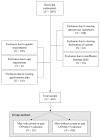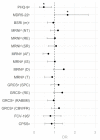Examining the Role of Traditional Masculinity and Depression in Men's Risk for Contracting COVID-19
- PMID: 35323399
- PMCID: PMC8945728
- DOI: 10.3390/bs12030080
Examining the Role of Traditional Masculinity and Depression in Men's Risk for Contracting COVID-19
Abstract
In the light of the COVID-19 pandemic and claims that traditional masculinity may put some men at increased risk for infection, research reporting men's health behaviors is critically important. Traditional masculine norms such as self-reliance and toughness are associated with a lower likelihood to vaccinate or follow safety restrictions. Furthermore, infection risk and traditional masculinity should be investigated in a differentiated manner including gender role orientation, underlying traditional masculine ideologies and male gender role conflict. In this pre-registered online survey conducted during March/April 2021 in German-speaking countries in Europe, 490 men completed questionnaires regarding contracting COVID-19 as confirmed by a validated test, fear of COVID-19 (FCV-19S), and experience of psychological burden due to COVID-19. In addition, depression symptomatology was assessed by using prototypical internalizing and male-typical externalizing depression symptoms. Furthermore, self-identified masculine gender orientation, endorsement of traditional masculinity ideologies, and gender role conflict were measured. A total of 6.9% of men (n = 34) reported having contracted COVID-19 since the beginning of the pandemic. Group comparisons revealed that men who had contracted COVID-19 exhibited higher overall traditional masculine ideology and gender role conflict. Logistic regression controlling for confounders (age, income, education, and sexual orientation) indicated that only depression symptoms are independently associated with the risk of having contracted COVID-19. While prototypical depression symptoms were negatively associated with the risk of having contracted COVID-19, male-typical externalizing depression symptoms were positively associated with the risk of contracting COVID-19. For traditional masculinity, no robust association for an increased risk of contracting COVID-19 could be established, while higher male-typical externalizing depression symptoms were associated with an increased risk of contracting COVID-19.
Keywords: COVID-19; MDRS-22; depression; traditional male role norms; traditional masculinity.
Conflict of interest statement
The authors declare no conflict of interest.
Figures




Similar articles
-
Masculinity, alexithymia, and fear of intimacy as predictors of UK men's attitudes towards seeking professional psychological help.Br J Health Psychol. 2015 Feb;20(1):194-211. doi: 10.1111/bjhp.12089. Epub 2014 Jan 30. Br J Health Psychol. 2015. PMID: 24479947
-
Masculinity and Depression: A Longitudinal Investigation of Multidimensional Masculine Norms Among College Men.Am J Mens Health. 2018 Nov;12(6):1873-1881. doi: 10.1177/1557988318785549. Epub 2018 Jul 4. Am J Mens Health. 2018. PMID: 29973104 Free PMC article.
-
Men's Psychotherapy Use, Male Role Norms, and Male-Typical Depression Symptoms: Examining 716 Men and Women Experiencing Psychological Distress.Behav Sci (Basel). 2021 Jun 2;11(6):83. doi: 10.3390/bs11060083. Behav Sci (Basel). 2021. PMID: 34199633 Free PMC article.
-
Masculinity and HIV: Dimensions of Masculine Norms that Contribute to Men's HIV-Related Sexual Behaviors.AIDS Behav. 2016 Apr;20(4):788-98. doi: 10.1007/s10461-015-1264-y. AIDS Behav. 2016. PMID: 26696261 Free PMC article. Review.
-
What's Right With Men? Gender Role Socialization and Men's Positive Functioning.Am J Mens Health. 2019 Jan-Feb;13(1):1557988318806074. doi: 10.1177/1557988318806074. Epub 2018 Oct 12. Am J Mens Health. 2019. PMID: 30311816 Free PMC article. Review.
Cited by
-
Empowering Men to Take Control of Their Own Health: Development and Validation of the Men's Response to Colorectal Cancer Screening Scale (MR-CCSS).Healthcare (Basel). 2025 Jun 15;13(12):1433. doi: 10.3390/healthcare13121433. Healthcare (Basel). 2025. PMID: 40565460 Free PMC article.
-
The Roles of Endorsement and Stigma in Suicidal Ideation and Behavior among Chinese College Students.Int J Environ Res Public Health. 2023 Jan 3;20(1):877. doi: 10.3390/ijerph20010877. Int J Environ Res Public Health. 2023. PMID: 36613198 Free PMC article.
-
Gender Role Discrepancy Stress and COVID-19 Prevention Behaviors Among Men in the United States.Am J Health Promot. 2023 Jul;37(6):766-777. doi: 10.1177/08901171231152140. Epub 2023 Jan 17. Am J Health Promot. 2023. PMID: 36648009 Free PMC article.
References
-
- Li M., Zhang Z., Cao W., Liu Y., Du B., Chen C., Liu Q., Uddin M.N., Jiang S., Chen C., et al. Identifying Novel Factors Associated with COVID-19 Transmission and Fatality Using the Machine Learning Approach. Sci. Total Environ. 2021;764:142810. doi: 10.1016/j.scitotenv.2020.142810. - DOI - PMC - PubMed
-
- Bridges T., Barber K., Nelson J.D., Chatillon A. Masculinity and COVID-19: Symposium Introduction. Men Masc. 2021;24:163–167. doi: 10.1177/1097184X211004325. - DOI
-
- Courtenay W.H. Engendering Health: A Social Constructionist Examination of Men’s Health Beliefs and Behaviors. Psychol. Men Masc. 2000;1:4–15. doi: 10.1037/1524-9220.1.1.4. - DOI
LinkOut - more resources
Full Text Sources
Miscellaneous

